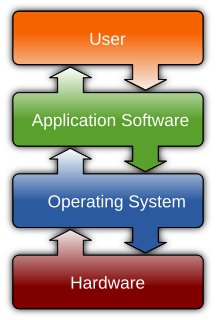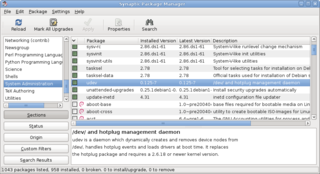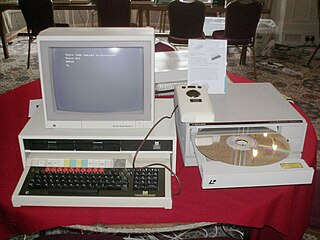
Computer software, or simply software, is a collection of data or computer instructions that tell the computer how to work. This is in contrast to physical hardware, from which the system is built and actually performs the work. In computer science and software engineering, computer software is all information processed by computer systems, programs and data. Computer software includes computer programs, libraries and related non-executable data, such as online documentation or digital media. Computer hardware and software require each other and neither can be realistically used on its own.

A computer program is a collection of instructions that performs a specific task when executed by a computer. A computer requires programs to function.

Data storage is the recording (storing) of information (data) in a storage medium. DNA and RNA, handwriting, phonographic recording, magnetic tape, and optical discs are all examples of storage media. Recording is accomplished by virtually any form of energy. Electronic data storage requires electrical power to store and retrieve data.

A package manager or package management system is a collection of software tools that automates the process of installing, upgrading, configuring, and removing computer programs for a computer's operating system in a consistent manner.

Esri is an international supplier of geographic information system (GIS) software, web GIS and geodatabase management applications. The company is headquartered in Redlands, California.

Digital obsolescence is a situation where a digital resource is no longer readable because of its archaic format: the physical media, the reader, the hardware, or the software that runs on it is no longer available.

In computing, a file system or filesystem controls how data is stored and retrieved. Without a file system, information placed in a storage medium would be one large body of data with no way to tell where one piece of information stops and the next begins. By separating the data into pieces and giving each piece a name, the information is easily isolated and identified. Taking its name from the way paper-based information systems are named, each group of data is called a "file". The structure and logic rules used to manage the groups of information and their names is called a "file system".
In computer security, a vulnerability is a weakness which can be exploited by a threat actor, such as an attacker, to perform unauthorized actions within a computer system. To exploit a vulnerability, an attacker must have at least one applicable tool or technique that can connect to a system weakness. In this frame, vulnerability is also known as the attack surface.
UVC-based preservation is an archival strategy for handling the preservation of digital objects. It employs the use of a Universal Virtual Computer (UVC)—a virtual machine (VM) specifically designed for archival purposes, that allows both emulation and migration to a language-neutral format like XML.
Records management, also known as records and information management, is an organizational function devoted to the management of information in an organization throughout its life cycle, from the time of creation or inscription to its eventual disposition. This includes identifying, classifying, storing, securing, retrieving, tracking and destroying or permanently preserving records. The ISO 15489-1: 2001 standard defines records management as "[the] field of management responsible for the efficient and systematic control of the creation, receipt, maintenance, use and disposition of records, including the processes for capturing and maintaining evidence of and information about business activities and transactions in the form of records".
Digital permanence addresses the history and development of digital storage techniques, specifically quantifying the expected lifetime of data stored on various digital media and the factors which influence the permanence of digital data. It is often a mix of ensuring the data itself can be retained on a particular form of media and that the technology remains viable. Where possible, as well as describing expected lifetimes, factors affecting data retention will be detailed including potential technology issues.

Fedora is a digital asset management (DAM) architecture upon which institutional repositories, digital archives, and digital library systems might be built. Fedora is the underlying architecture for a digital repository, and is not a complete management, indexing, discovery, and delivery application. It is a modular architecture built on the principle that interoperability and extensibility are best achieved by the integration of data, interfaces, and mechanisms as clearly defined modules.
The digital dark age is a lack of historical information in the digital age as a direct result of outdated file formats, software, or hardware that becomes corrupt, scarce, or inaccessible as technologies evolve and data decay. Future generations may find it difficult or impossible to retrieve electronic documents and multimedia, because they have been recorded in an obsolete and obscure file format. The name derives from the term Dark Ages in the sense that there could be a relative lack of records in the digital age, as documents are transferred to digital formats and original copies are lost. An early mention of the term was at a conference of the International Federation of Library Associations and Institutions (IFLA) in 1997.[1] The term was also mentioned in 1998 at the Time and Bits conference,[2][3] which was co-sponsored by the Long Now Foundation and the Getty Conservation Institute.
Digital curation is the selection, preservation, maintenance, collection and archiving of digital assets. Digital curation establishes, maintains and adds value to repositories of digital data for present and future use. This is often accomplished by archivists, librarians, scientists, historians, and scholars. Enterprises are starting to use digital curation to improve the quality of information and data within their operational and strategic processes. Successful digital curation will mitigate digital obsolescence, keeping the information accessible to users indefinitely.
A file format is a standard way that information is encoded for storage in a computer file. It specifies how bits are used to encode information in a digital storage medium. File formats may be either proprietary or free and may be either unpublished or open.

Metadata is "data [information] that provides information about other data". Many distinct types of metadata exist, among these descriptive metadata, structural metadata, administrative metadata, reference metadata and statistical metadata.
A digital library, digital repository, or digital collection, is an online database of digital objects that can include text, still images, audio, video, or other digital media formats. Objects can consist of digitized content like print or photographs, as well as originally produced digital content like word processor files or social media posts. In addition to storing content, digital libraries provide means for organizing, searching, and retrieving the content contained in the collection.
The following outline is provided as an overview of and topical guide to databases:
Information technology (IT) is the use of computers to store, retrieve, transmit, and manipulate data, or information, often in the context of a business or other enterprise. IT is considered to be a subset of information and communications technology (ICT). An information technology system is generally an information system, a communications system or, more specifically speaking, a computer system – including all hardware, software and peripheral equipment – operated by a limited group of users.